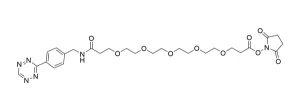Bis-dPEG®25-NHS ester, product number QBD-10968, is a homobifunctional, amine-reactive, single molecular weight PEG crosslinker with a long (79 atoms, 93.0 Å) discrete PEG (dPEG®) chain length. Each end of the chain terminates as the N-hydroxysuccinimidyl (NHS) ester of propionic acid. Unlike traditional hydrophobic crosslinkers, Bis-dPEG®25-NHS ester will not cause problems such as aggregation, precipitation, and inactivation when conjugated to biomolecules. As a homobifunctional, amine-reactive crosslinker, the primary uses for QBD-10968 are intermolecular conjugation of biomolecules with free, surface-accessible amines and intramolecular modification of biomolecules using free, surface-accessible amines. Because QBD-10968 is one in a line of similar products, Bis-dPEG®25-NHS ester can be used with other products in the same line to probe the effect of different linker lengths on the performance of crosslinked or intramolecularly modified biomolecules.
NHS esters react with free amines such as the ε-amines of lysine. The optimal pH range for NHS esters to react with free amines is 7.0 – 7.5. However, NHS esters can react with free amines with pH as low as 6.5. NHS esters are susceptible to hydrolysis in aqueous media. As the pH increases, the hydrolysis rate of the ester increases. Thus, we strongly discourage storing Bis-dPEG®25-NHS ester in water or aqueous buffer. Instead, we recommend that customers make new solutions of the product as needed, use them immediately, and discard unused solutions after use. If customers desire to store the product in solution, we recommend the use of a pure, anhydrous, water-miscible solvent such as dimethyl sulfoxide (DMSO), N,N-dimethylacetamide (DMAC), or N,N-dimethylformamide (DMF). DMSO, DMAC, or DMF can be dried chemically or by storing for a minimum of 24 hours over 3 Å molecular sieves. With DMF, use only fresh solvent as the compound decomposes over time to form free amines that will react with the NHS esters.
| Unit Size | 100mg, 1000mg |
|---|---|
| Molecular Weight | 1413.55; single compound |
| Chemical formula | C₆₂H₁₁₂N₂O₃₃ |
| CAS | 1008402-79-6 |
| Purity | > 97% |
| Spacers | dPEG® Spacer is 79 atoms and 93.0 Å |
| Shipping | Ambient |
| Typical solubility properties (for additional information contact Customer Support) | Methylene chloride, Acetonitrile, DMAC or DMSO. |
| Storage and handling | -20°C; Always let come to room temperature before opening; be careful to limit exposure to moisture and restore under an inert atmosphere; stock solutions can be prepared with dry solvent and kept for several days (freeze when not in use). dPEG® pegylation compounds are generally hygroscopic and should be treated as such. This will be less noticeable with liquids, but the solids will become tacky and difficult to manipulate, if care is not taken to minimize air exposure. |
Greg T. Hermanson, Bioconjugate Techniques, 3rd Edition, Elsevier, Waltham, MA 02451, 2013, ISBN 978-0-12-382239-0; See Chapter 18, Discrete PEG Reagents, pp. 787-821, for a full overview of the dPEG® products.
Multivalent Benzamidine Molecules for Plasmin Inhibition: Effect of Valency and Linker Length. Tanmaye Nallan Chakravarthula, Dr. Ziqian Zeng, Prof. Nathan J. Alves. ChemMedChem, Volume 17, Issue 22, (2022), 09/16/2022, https://doi.org/10.1002/cmdc.202200364.
Applicable patents and legal notices are available at legal notices.




Stay in the Loop. Join Our Online Community
Products
Ordering
About Us
Application
Resources

©Vector Laboratories, Inc. 2025 All Rights Reserved.
To provide the best experiences, we use technologies like cookies to store and/or access device information. Consenting to these technologies will allow us to process data such as browsing behavior or unique IDs on this site. Not consenting or withdrawing consent, may adversely affect certain features and functions. Privacy Statement
How do I Request a Quote?
To request a quote for products: